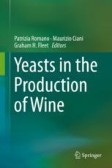Search
Search Results
-
Antimicrobial Compounds in Wine
Ipsum vinum est potestas et possession (wine itself is power and possession). Wine is a complex system that triggers multisensory cognitive stimuli....

-
Production of Malt-Based Beverages
A malt beverage is a fermented drink that is generally made from cereal grain such as barley that has been malted that involves germinating the grain...
-
Yeast bioprospecting versus synthetic biology—which is better for innovative beverage fermentation?
Producers often utilise some of the many available yeast species and strains in the making of fermented alcoholic beverages in order to augment...

-
Measures to improve wine malolactic fermentation
This review focuses on the considerable amount of research that has been directed towards the improvement of efficiency and reliability of malolactic...

-
Gene Expression in Yeasts During Wine Fermentation
The analysis of gene regulation and changes in transcript profiles for important model organisms in their natural environments provides critical...
-
Valorization of apple and grape wastes with malic acid-degrading yeasts
It is estimated that more than 20% of processed apples and grapes are discarded as waste, which is dominated by pomace rich in malic acid that could...

-
Yeast Ecology of Wine Production
The ecological distribution of yeasts through the various stages of winemaking process have an important role on the characteristics of wines...
-
A concise review of the highly diverse genus Sargassum C. Agardh with wide industrial potential
Sargassum C. Agardh is a highly diverse genus within the brown algae, with 615 currently recognized species, varieties and forms worldwide. This high...

-
Yeasts Associated With Biological Ageing of Fortified Wines
Fortified wines are obtained by adding ethanol at some point during grape fermentation, in order to stabilize them and avoid wine spoilage....
-
Yeasts Associated With the Production of Distilled Alcoholic Beverages
Distilled alcoholic beverages are produced firstly by fermenting sugars emanating from cereal starches (in the case of whiskies), sucrose-rich plants...
-
Genetic Improvement of Wine Yeasts
In recent years, wine market is undergoing a change due to the ever-growing request to improve the sensory features and nutritional properties of the...
-
Diversity of Natural Yeast Flora of Grapes and Its Significance in Wine Making
The biodiversity of yeasts associated with grapes has been studied in different regions of wine producing countries throughout the world. Most of the...
-
Characterisation of yeast microbiota, chemical and sensory properties of organic and biodynamic Sangiovese red wines
Wine quality is closely linked to the fermentation step, which is driven by the microbial ecology of grape and the use of selected microbial strains...

-
Rhodoferax koreense sp. nov, an obligately aerobic bacterium within the family Comamonadaceae, and emended description of the genus Rhodoferax
Gram-staining-negative, uniflagellated, rod-shaped, designated as DCY110 T , was isolated from sludge located in Gangwon province, Republic of Korea....
-
Polysaccharide Production by Grapes Must and Wine Microorganisms
In this chapter, we describe the formation of polysaccharides (PS) by some of the microorganisms most frequently encountered in grapes, must and...
-
Lactobacillus oligofermentans glucose, ribose and xylose transcriptomes show higher similarity between glucose and xylose catabolism-induced responses in the early exponential growth phase
BackgroundLactobacillus oligofermentans has been mostly isolated from cold-stored packaged meat products in connection with their spoilage, but its...

-
Implications of new research and technologies for malolactic fermentation in wine
The initial conversion of grape must to wine is an alcoholic fermentation (AF) largely carried out by one or more strains of yeast, typically Saccharom...

-
A mathematical model of the link between growth and L-malic acid consumption for five strains of Oenococcus oeni
In winemaking, after the alcoholic fermentation of red wines and some white wines, L-malic acid must be converted into L-lactic acid to reduce the...

-
Microbiological and chemical monitoring of Marsala base wine obtained by spontaneous fermentation during large-scale production
The present work was undertaken to evaluate the effect of natural wine making on the microbial and chemical composition of Marsala base wine. To this...

-
Cosmetic Ingredients Fermented by Lactic Acid Bacteria
There is an interesting relationship between the skin and fermentation of lactic acid bacteria lactic acid bacteria...
